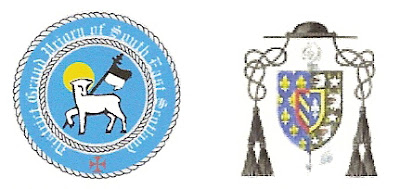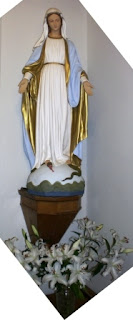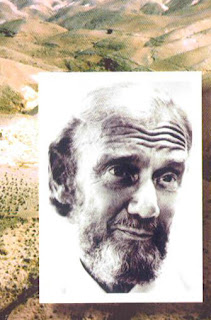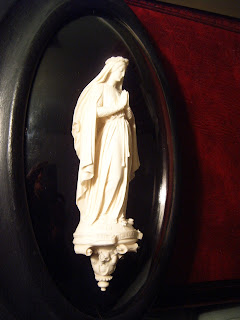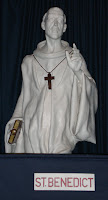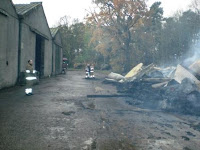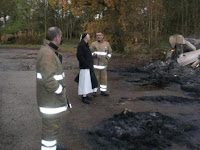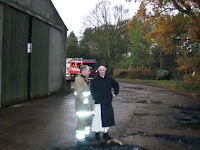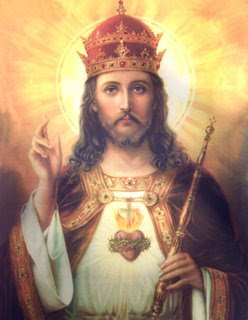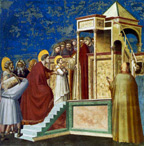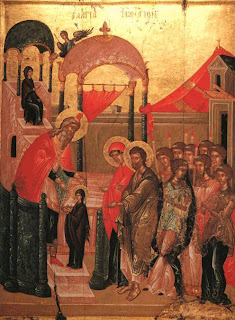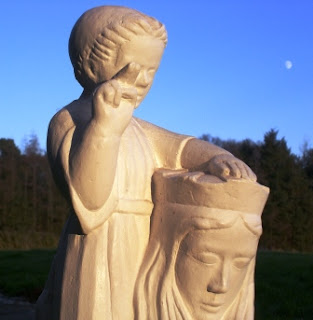
Striking Gold on a Vanishing Reading from Ambrose of Milan.
The ‘pale moon was rising’ on the 20th December when I took this snap of the Child Jesus head high over Mary in the Hew Lorimer sculpture of Our Lady of the Isles. The figure in the picture was the preliminary "maquet" made by the artist for the granite statue on South Uist.
In this model the Child Jesus places his left hand on top Mary’s head with great assurance, and looks out to the world with his right hand in the sign of blessing. One could accompany a video of the subject with the Great O Antiphons expressing the titles of the Saviour in the last seven days preparing for Christmas. O come, O come, Emmanuel, (John M Neal).
In that context the Reading at the Night Office was ringing bells for me this morning, 21st December. It so happens that this wonderful Reading does not appear in the more recent Edition of Word in Season. Not to worry, the same Reading is part of the ‘Breviary’ for today. (Note: ‘Word in Season’ 1981 Edition. New edition 2001).
During Advent we think of the two persons most directly involved in the history of our salvation: Saint John the Baptist and our Lady. Ambrose shows how God prepared each of them for their vocation, and then applies Elizabeth's words to each individual believer. The commentary from which this passage is taken is made up of homilies given between 377 and 389.
She was anxious to be of service and joy impelled her to make haste. Filled with God, where could she hasten but to the heights? The Holy Spirit does not proceed by slow, laborious efforts. Quickly, too, the blessings of her coming and of the Lord's presence were revealed: As soon as Elizabeth heard Mary's greeting the child leapt in her womb and she was filled with the Holy Spirit.
Notice the choice of words and the meaning of each one. Elizabeth was the first to hear Mary's voice, but John was the first to be aware of grace. She heard with the ears of the body; he leapt for joy because of the mystery. She was aware of Mary's presence, he of the Lord's. The woman perceived the presence of a woman, the child that of a child. The women spoke of God's grace while the children gave effect to it within them, revealing to their mothers the mystery of love, and by a double miracle the mothers prophesied under the inspiration of their sons.
The child leapt in the womb; the mother was filled with the Holy Spirit. The mother was not filled before her son, but once he had been filled with the Holy Spirit, he filled his mother too. John leapt for joy and so did the spirit of Mary. When John leapt Elizabeth was filled with the Holy Spirit, but we do not learn that Mary was then filled with the Holy Spirit, only that her spirit rejoiced.

Her son, who is beyond our understanding, was active in his mother in a way beyond our understanding. Elizabeth was filled with the Holy Spirit after conceiving a son; Mary was filled before. You are blessed, said Elizabeth; because you have believed. You too are blessed because you have heard and believed.
The soul of every believer conceives and brings forth the Word of God and recognizes his works. Let Mary's soul be in each of you to glorify the Lord. Let her spirit be in each of you to rejoice in the Lord. Christ has only one mother in the flesh, but we all bring forth Christ by faith. Every soul free from the contamination of sin and inviolate in its purity can receive the Word of God. The soul that attains this goal glorifies the Lord just as Mary's soul did, while her spirit rejoiced in God her Saviour. The Lord is glorified, as we read also in another text, Glorify the Lord with me, not because the human voice can add anything to the Lord, but because the Lord grows and is glorified within us. Since Christ is the image of God, the soul that does what is right and holy makes brighter that image of God in whose likeness it was made, and in so doing is exalted by a certain participation in its grandeur.
From a commentary on Saint Luke's gospel by Saint Ambrose (Ub. 2, 19.22-23.26-27;CCL 14, 39-42)

